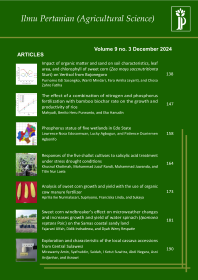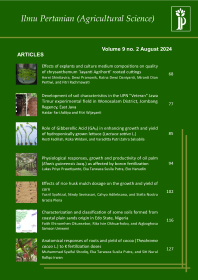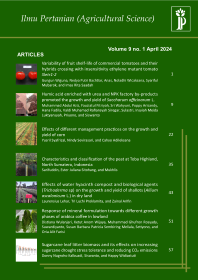
Evaluation of the crossings between local and drought-tolerant rice varieties using simple sequence repeat (SSR) molecular marker
Aditya Wahyudhi(1*), Lintang Restu Pratiwi(2), Panjisakti Basunanda(3)
(1) Department of Agronomy, Faculty of Agriculture, Universitas Gadjah Mada Jln. Flora no.1, Bulaksumur, Sleman, Yogyakarta 55281, Indonesia
(2) Department of Agronomy, Faculty of Agriculture, Universitas Gadjah Mada Jln. Flora no.1, Bulaksumur, Sleman, Yogyakarta 55281, Indonesia
(3) Department of Agronomy, Faculty of Agriculture, Universitas Gadjah Mada Jln. Flora no.1, Bulaksumur, Sleman, Yogyakarta 55281, Indonesia
(*) Corresponding Author
Abstract
Two cultivars of local rice, namely Mentik Wangi and Mentik Susu, have been grown around west to south flank of Merapi volcano. They are highly valued for their good taste and cooking characteristics. An attempt to introduce drought-tolerant rice varieties has been conducted by crossing them with two sources, namely Kasalath and Bluebonnet. Molecular-assisted selection using a set of SSR markers was applied to check the F1 and F2 generation trueness and segregation. This research was conducted in the facilities of Department of Agronomy, Faculty of Agriculture, Universitas Gadjah Mada, Yogyakarta. The research was a field experiment arranged in a completely randomized design, consisting of Mentik Wangi, Mentik Susu, Bluebonnet, and Kasalath, as well as their crossings’ F1 and F2 plants as treatments. The SSR markers used are RM72, RM228, RM518, and RM20(A). Polymorphism test of the parents showed that polymorphism exists between local and donor parents, thus these markers were considered eligible for the F1 and F2 tests. The heterozygous individuals of F1 were 75% for Bluebonnet × Mentik Wangi, 44.4% for Bluebonnet × Mentik Susu, and 46.7% for Mentik Wangi × Bluebonnet; all were consistent in every primer used. We could not confirm that the F2 populations showed segregation pattern that followed Mendelian segregation in some crosses due to too small size of the sample. Heterozygous individuals in F2 showed the differences pattern for each marker, indicating that the location of the SSR markers were far from each other in the genome.
Keywords
Full Text:
PDFReferences
Aboulila, A.A. (2015). Marker assisted selection for genetic improvement of drought tolerance in hybrid rice (Oryza sativa L.). International Journal of Biotechnology Research, 3(3), pp. 045-054.
Al-Faifi, S.A., Migdadi, H.M., Algamdi, S.S., Khan, M.A., Ammar, M.H., Al-Obeed, R.S., Al-Thamra, M.I., EL-Harty, E.H., and Jakse, J. (2016). Development, characterization and use of genomic SSR markers for assessment of genetic diversity in some Saudi date palm (Phoenix dactylifera L.) cultivars. Electronic Journal of Biotechnology, 21, pp. 18–25.
Anupam, A., Imam, J., Quatadah, S.M., Siddaiah, A., Das, S.P., Variar, M., and Mandal, N.P. (2017). Genetic diversity analysis of rice germplasm in tripura state of northeast india using drought and blast linked markers. Rice Science, 24(1), pp. 10-20.
Barik, S.R., Pandit, E., Pradhan, S.K., Singh, S., Swain, P., and Mohapatra, T. (2018). QTL mapping for relative water content trait at reproductive stage drought stress in rice. Indian Journal of Genetics and Plant Breeding, 78(4), pp. 401-408.
Bernier, J., Kumar, A., Ramaiah, V., Spaner, D., and Atlin, G. (2007). A largeeffect QTL for grain yield under reproductive stage drought stress in upland rice. Crop Science, 47(2), pp. 507-518.
Freeg, H.A., Anis, G.B., Abo-Shousha, A.A., El-Banna, A.N., Sabagh, A.E. (2016). Genetic diversity among some rice genotypes with different drought tolerance based on SSR markers. Cercetări Agronomice în Moldova, 49(3), pp. 39-50.
Fukuta, Y., Konisho, K., Senoo-namai, S., and Yanagihara, S. (2012). Genetic characterization of rainfed upland New Rice for Africa (NERICA) varieties. Breeding Science, 62(1), pp. 27–37.
Lestari, P., Reflinur, Handoko, D.D., and Mastur. (2018). Keragaman genetik varietas padi japonica dan indica berdasarkan marka DNA terkait mutu rasa. Scripta Biologica, 5(1), pp. 21-25.
Lin, M.H., Lin, C.W., Chen, J.C., Lin, Y.C., Cheng, S.Y., Liu, T.H., Jan, F.J., Wu, S.T., Thseng, F.S., and Ku, H.M. (2007). Tagging rice drought-related QTL with SSR DNA markers. Crop, Environment and Bioinformatics, 4, pp. 65-76.
Mishra, K.K., Vikram, P., Yadaw, R.B., Swamy, B.P.M., Dixit, S., Cruz, M.T.S.C., Maturan, P., Marker, S., and Kumar, A. (2013). qDTY12.1 : a locus with a consistent effect on grain yield under drought in rice. BMC Genetics, 14 (12), pp. 1471-2156.
Ramadan, E. A., Elmoghazy, A.M., and El-Mowafi, H. F. (2015). Molecular markers based genetic diversity analysis for drought tolerance in rice (Oryza sativa L.) using SSR markers. International Journal of Scientific Research in Agricultural Sciences, 2, pp. 137-146.
Sahoo, J.P. and Sharma, V. (2018). Impact of LOD score and recombination frequencies on the microsatellite marker based linkage map for drought tolerance in kharif rice of assam. International Journal of Current Microbiology and applied Sciences,7(8), pp. 3299-3304.
Shehata A.I., Al-Ghethar, H.A., and Al-Homaidan, A.A. (2009). Application of simple
sequence repeat (SSR) markers for molecular diversity and heterozygosity
analysis in maize inbred lines. Saudi Journal of Biological Sciences, 16(2), pp. 57-62.
Solis, J., Gutierrez, A., Mangu, V., Sanchez, E., Bedre, R., Linscombe, S., and Baisakh, N. (2018). Genetic mapping of QTL for grain yield under drought in rice under controlled green house conditions. Frontiers in Chemistry, 5, pp. 129-143.
Sraphet, S., Smith, D.R., and Triwitayakorn, K. (2015). Isolation and characterization of microsatellite loci and genetic diversity in cassava (Manihot esculenta Crantz). Journal of Crop Improvement, 29(4), pp. 447-454.
Susanto, U., Daradjat, A.A., and Suprihatno, B. (2003). Perkembangan pemuliaan padi sawah di Indonesia. Jurnal Litbang Pertanian, 22(3), pp. 125-131.
Sutton, W.S. (1903). The chromosomes in heredity. Biological Bulletin, 4(5), pp. 231-251.
Swamy, B.P., Ahmed, H.U., Henry, A., Mauleon, R., Dixit, S., Vikram, P., Tilatto, R., Verulkar, S.B., Perraju, P., Mandal, N.P., Variar, M., Robin, S., Chandrababu, R., Singh, O.N., Dwivedi, J.L., Das, S.P., Mishra, K.K., Yadaw, R.B., Aditya, T.L., Karmakar, B., Satoh, K., Moumeni, A., Kikuchi, S., Leungh, H., and Kumar, A. (2013). Genetic, physiological and gene expression analyses reveal that multiple QTL enhance yield of rice mega variety IR64 under drought. Plos One, 8(5), pp. 1-11.
Tabien, R.E., Samonte, S.O.PB., and McClung, A.M. (2008). Forty-eight years of rice improvement in Texas since the release of cultivar Bluebonnet in 1944. Crop Science, 48, pp. 2097-2106.
Thomson, M.J., Septiningsih, E.M., Suwardjo, F., Santoso, T.J., Silitonga, T.S., and Mccouch, S.R. (2007). Genetic diversity analysis of traditional and improved Indonesian rice (Oryza sativa L.) germplasm using microsatellite markers. Theoritical and Applied Genetics, 114(3), pp. 559–568.
Thumilan B.M., Sajeevan, R.S., Biradar, J., Madhuri, T., Nataraja, K.N., and Sreeman, S.M. (2016). Development and characterization of genic SSR markers from Indian Mulberry transcriptome and their transferability to related species of Moraceae. Plos One, 11(9), pp. 1-18.
Yulianto, Sutoyo and Prayudi, B. (2014). Penyebaran penyakit blas pada tanaman padi di dataran rendah dan dataran tinggi Jawa Tengah. Seminar Hasil-Hasil Penelitian Pengkajian DIPA-APBN 2013 BPTP Jawa Tengah. Ungaran, pp. 26.
Article Metrics
Refbacks
- There are currently no refbacks.
Ilmu Pertanian (Agricultural Science) ISSN 0126-4214 (print), ISSN 2527-7162 (online) is published by Faculty of Agriculture Universitas Gadjah Mada collaboration with Perhimpunan Sarjana Pertanian Indonesia (PISPI) and licensed under a Creative Commons Attribution-ShareAlike 4.0 International License.













